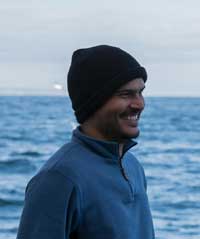Dr. Amir Haroon (Geomar Kiel): Integrated marine Controlled Source Electromagnetic applications for detecting freshened groundwater in coastal regions
Geoscientific Colloquium lecture on 3rd November, 12:15 in GEO 1550

Examples of seawater intrusion into coastal aquifers, groundwater dominated coastal ecosystems, and the potential use of offshore freshened groundwater as a resource in arid coastal communities highlight the intimate relationship between groundwater, oceans, and society. Hence, understanding the mechanisms controlling salinity distributions along coastal zones, and particularly across the coastline to the offshore domain is not only important from a resource perspective, but also invaluable for protecting terrestrial groundwater reserves and coastal ecosystems from induced seawater intrusion and land subsidence. In terrestrial groundwater studies, electrical/electromagnetic methods have proven effective on various spatial scales. Because electromagnetic signals are sensitive to variations in pore fluid salinity patterns, several ground-based and airborne methods have been applied to understand the onshore component of coastal aquifer systems. Yet, freshened groundwater may exist several kilometers offshore, but cannot be characterized effectively using the ground- or airborne-based geophysical technologies. Here, controlled-source electromagnetic applications, in both time- and frequency domain, have demonstrated a high degree of sensitivity for delineating sub-seafloor pore fluid freshening in various geological settings, including siliciclastic Continental shelves, carbonate margins, or volcanic Islands. This talk will present recent controlled-source electromagnetic applications in near-coastal environments and discuss future developments needed for detecting, investigating, and monitoring groundwater interactions in coastal regions to assess the resource potential of offshore groundwater and to help safe-guard coastal groundwater reserves.
Geowissenschaftliches Kolloquium "Perspectives of non-seismic applied near-surface geophysics"
Further information:
Dr. Amir Haroon
e-Mail: aharoon@geomar.de
https://www.geomar.de/aharoon

